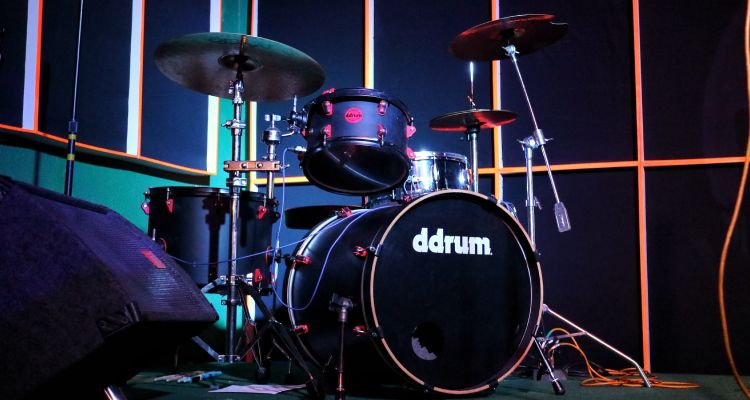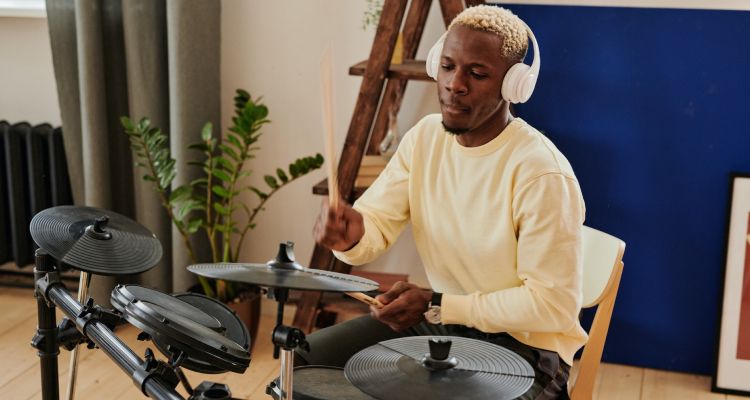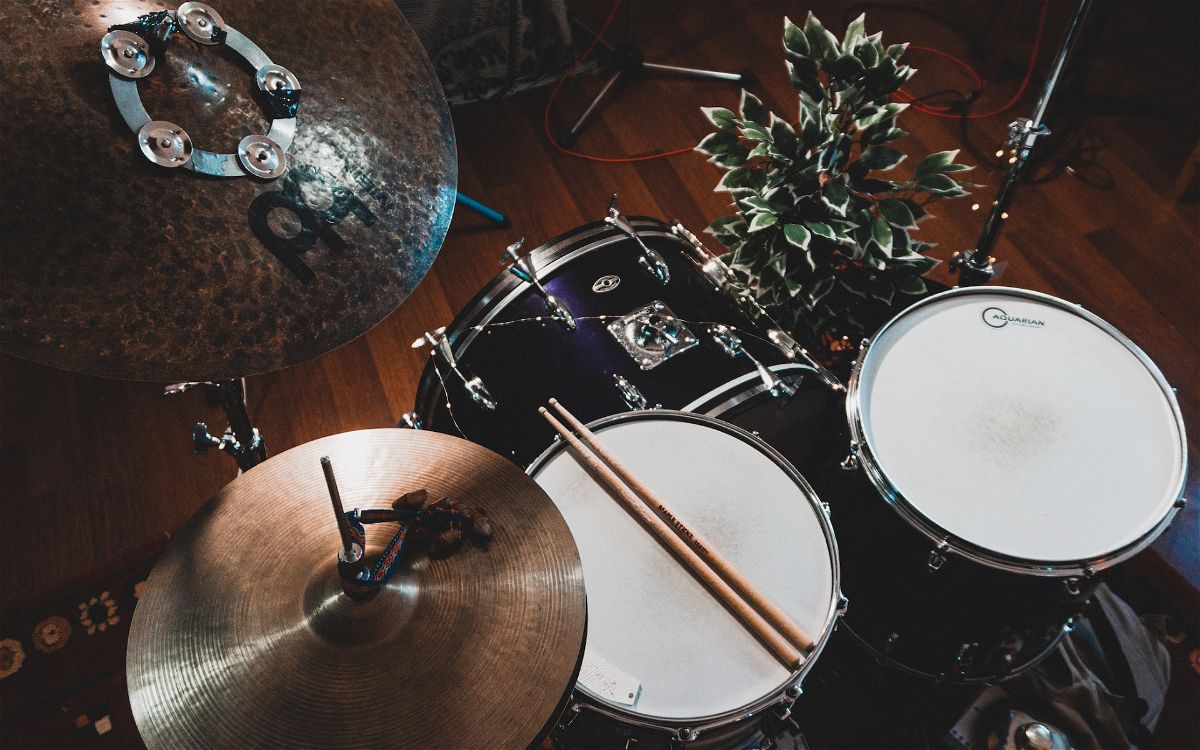Drums are one of the loudest instruments, and freely being able to practice at all times is a luxury that most of us don’t have.
Keeping noise levels down is something that all drummers have to deal with at some point, so a few successful strategies have popped up over the years.
If you need to make drums quieter, you’re not alone. I, and many others, have had to learn how to quieten drums over all the years that I’ve been playing.
Here are some tried and tested methods that are guaranteed to reduce the volume of drums and allow you to keep practicing.
Contents
How to Make Drums Quieter
Here’s a quick rundown of the best ways you can make your drumming quieter.
- Invest in an electronic drum set: they are much quieter than acoustic kits and allow you to play using headphones, minimizing the external noise.
- Install mesh drumheads and low-volume cymbals: these tools are designed to produce less sound without compromising the feel and response of playing.
- Time your practice sessions: especially if you live in a shared living space or have noise restrictions. Use a practice pad in between sessions on the acoustic kit.
- Communicate with neighbors or housemates: letting those around you know about your practice schedule and discuss potential solutions or compromises to help maintain a harmonious living environment.
- Optimize room acoustics: Adding acoustic panels or foam to the walls of your practice space can help absorb sound and reduce overall volume levels.
Soundproofing and Sound Insulating

Before we get into the working methods, it’s important to understand the concept of soundproofing first. A lot of people will tell you that hanging panels on the walls and blocking all the gaps in the windows and doors will do the trick, but that’s actually called sound insulation.
It makes the drums sound better in the room, and it drops the volume slightly due to all the harsh overtones being cut out, but it doesn’t drop the volume enough to keep peace with your neighbors.
To fully soundproof a room, you need to build another room within the room so that no sound can escape the air gap that you’ve created. It’s an expensive process, and it’s not something that we can all do easily.
Also, the drums will still be very loud in a soundproofed room, so you won’t be protecting your own ears when you play.
The following methods will drop the sound for both you and your neighbors.
Muffling
Muffling refers to when you put objects inside the shells or on top of the drumheads of an acoustic drum kit. A muffled drum won’t resonate as much, leading it to have a shorter and tighter sound.
Drums are at their loudest when they resonate freely, so applying muffling to a drum will drop the volume depending on how much you apply.
Bass drum muffling is important in drumming. Without muffling, bass drums have booming tones that fill a room up very quickly. The bass drum volume also travels through floors.
You can put a towel or a pillow inside the bass drum shell to stop it from booming so much, and a tight kick sound will be heard instead.
For the toms and snare dampening, you’ll need to attach dampening tools onto the drumheads. This could be Moongels, tape, or towels. The more muffling you add, the more dead the drums will sound. Sometimes, too much muffling makes them sound worse, but that’s okay for quiet practice.
Electronic Drums

If you know how to make drums quieter but you’re still getting noise complaints, you should consider buying a good electronic drum kit.
Electronic drum kits include a set of rubber or mesh drum pads with rubber cymbals. The volume you get from them is around the same level as what you hear when playing on a practice pad.
You have the benefit of connecting a set of headphones to hear all your drum parts without anyone else hearing them.
Most mesh pad kits like the Alesis Nitro are quiet enough not to bother anyone if you close the door while playing. However, the sound from the bass drum pad can still travel through the floor, so you may need to put the kit on an absorbing platform if you’re playing in an apartment space.
Getting an electronic kit isn’t ideal, considering that you have to buy a whole new set, but it’s one of the most effective ways of keeping drum noise down compared to playing acoustic drums.
Low Volume Cymbals and Drumheads
Low volume cymbals and drum heads are tools that you can put on your acoustic drum set to drop the sound by a significant amount.
Low volume cymbals have dozens of perforated holes in them, and they usually drop the sound level to about 20% to 40% compared to your regular cymbals. You can find low volume cymbals that are the same size as your regular ones, so it will still feel like you’re playing the same drum set.
Low volume drum heads are mesh drum heads that you place on your shells instead of regular heads. They feel the same as the mesh heads from electronic drums, and they also drop the sound levels significantly.
Remo and Zildjian used to offer the best low volume drumhead and cymbal package, but many other brands have introduced their own version of the concept. That gives you many options to pick from!
Brushes and Hot Rods

If you don’t want to add anything to your drum set to change how it sounds, consider using brushes or hot rods instead of regular drumsticks.
Brushes are mainly used for jazz drumming, as they produce sounds from the drums that work for jazz ballads. You can sweep them across the snare drum to create a brushing sound.
Hot rods are more versatile, as you can play all the same grooves and fill that you would play with regular drumsticks. They’ll just lower the volume of what you’re playing.
Another name for hot rods is rute sticks. These are sticks that have a bundle of thin sticks taped together. They feel a lot better to use compared to brushes if you’re just looking to play the same things on the kit.
Practice Pads
Practice pads are designed for practicing your hand technique and pattern playing without making too much noise. They’re typically quite small, allowing you to take them with you anywhere.
However, a good method of dropping the volume of your acoustic kit is to place a few pads on top of your drumheads. You can create a practice pad drum kit like this.
To quieten the cymbals, you can buy cymbal mutes that latch onto the wingnuts of all the cymbal stands.
You get cymbal mutes for the drums as well, but practice pads give you better stick response, and having the ability to take them anywhere makes them more versatile. So, I’d suggest using a combination of both instead of using only drum and cymbal mutes.
Dynamic Control
Another method of making drums quieter that people overlook is to work closely on your dynamic control. Playing the drums quietly is a lot harder than it sounds, but you’ll be able to play your kit without bothering anyone if you work on the skill.
It’s naturally not as satisfying as whacking the drums to make them resonate as much as possible, but it’s a viable way of playing to keep your neighbors happy.
A good way of playing softer is to keep your limb movements small. The higher you lift your arms to play the drums, the louder your strokes will be. Try your best to lift your wrists rather than your arms, and your dynamic control will improve over time.
You may have to play at gigs where you can’t make a lot of noise, so practicing this skill at home will help you for future settings.
Conclusion
There are several ways of knowing how to reduce drum noise, and each has its pros and cons. The best thing is to use a combination of the methods mentioned above to see which one you stick with the most.
Electronic drum kits are an easy solution vs acoustic drums, but it’s not one that everyone can do. It’s also the most expensive option besides fully soundproofing your practice space.
It’s both a blessing and a curse that drums are so loud. They sound epic when played in full force, but not everyone wants to hear them all the time. So, you need to make a plan to keep practicing, and all the tips I mentioned will work very well.









